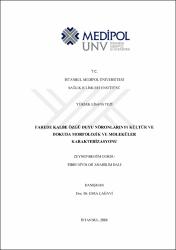| dc.contributor.advisor | Çağavi, Esra | |
| dc.contributor.author | Durdu, Zeynep Begüm | |
| dc.date.accessioned | 2021-09-29T07:15:57Z | |
| dc.date.available | 2021-09-29T07:15:57Z | |
| dc.date.issued | 2019 | en_US |
| dc.date.submitted | 2019-08-19 | |
| dc.identifier.citation | Durdu, Z. B. (2019). Farede kalbe özgü duyu nöronlarının kültür ve dokuda morfolojik ve moleküler karakterizasyonu. (Yayınlanmamış yüksek lisans tezi). İstanbul Medipol Üniversitesi Sağlık Bilimleri Enstitüsü, İstanbul. | en_US |
| dc.identifier.uri | https://hdl.handle.net/20.500.12511/8329 | |
| dc.description.abstract | Duyusal veriler kalpten beyne arka kök gangliyon (AKG) ve nodoz gangliyon (NG) vasıtası ile iletilir. Son yıllarda, akciğer, bağırsak, mide gibi organlara özgü duyu nöronları tanımlanmış olmasına rağmen kalbe özgü duyu nöronları henüz moleküler ve elektrofizyolojik düzeyde detaylı incelenmemiştir. Literatürde kalp ile ilişkili duyu sinir gövdelerinin NG ve AKG'de bulunduğunu gösteren araştırmalar, histolojik incelemeler ile sınırlı kalmıştır. Bu tez çalışması kapsamında farelerin kalbine retrograd bir boya olan Di-8-ANNEPPQ verilerek kalbe özgü duyu nöronları işaretlendi. AKG ve NG'ler işaretlenmeden bir hafta sonra doku ve hücresel düzeyde incelendi. İlk olarak kalbe özgü nöronları AKG ve NG'den ayrıştırılarak FACS ile saflaştırıldı. AKG'de kalbe özgü duyu nöronlarının, heterojen nöron popülasyonuna göre gövde alanı ve akson kalınlığının anlamlı olarak küçük olduğunu belirledik. Bu veri kalbe özgü nöronların farklı bir subpopülasyona ait olabileceğini ve küçük çaplı ağrı nöronlarını içerdiğini göstermektedir. NG ve AKG'de ağrı reseptör gen ifade analizi yapıldı ve önceki çalışmada yaptığımız transkriptom analizi ile uyumlu veriler elde edildi. Kalbe özgü duyu nöronlarındaki ağrı reseptör genleri IHC ile incelendiğinde, TRPV1'in doku boyutunda anlatımı olduğu ve işaretli hücrelerle örtüştüğü görülürken, P2RX2 ve SCN10A anlatımının daha az olduğu ve örtüşmediğini tespit ettik. NG ve omuriliğin C8 ve T1-T5 seviyesinde konumlanan AKG'lerde doku boyutunda 3-boyutlu haritalama sonucu Di-8-ANNEPPQ ile işaretli hücrelerin dokuda heterojen bir dağılım gösterdiği ve toplam nöron populasyonunun NG'de yaklaşık %5'ini, AKG'lerde %1-3'ünü oluşturduğu belirlenmiştir. Sonuç olarak bu tez çalışması ile literatürde ilk kez kalbe özgü NG ve AKG duyu nöronlarının dokuda lokalizasyonu ve oranı tespit edilmiştir. Elde ettiğimiz bulgular, kalbe özgü duyu nöronlarının tanımlanması ve kalp-sinir sistemi etkileşiminin sistemler seviyesinde anlaşılmasına katkı sağlama potansiyeline sahiptir. | en_US |
| dc.description.abstract | Sensory information from the heart is transferred to the brain via the dorsal root ganglion (DRG) and nodose ganglion (NG). Although, internal organs, such as lung, intestine, and stomach, have specific sensory neuron populations, heart-specific sensory neurons (HSSN) have not been described in a molecular level, yet. In the literature, sensory neuron axons innervating have been examined on the sensory nerve nodes. However, these studies have been limited to histological analysis. In this thesis study, a retrograde Di-8-ANNEPPQ dye, was injected into the hearts of mice. One week after the labelling, the DRG and NG were dissociated and the HSSN were isolated using FACS to be examined in the cell culture. As a result of our morphological analysis of DRG and NG cells, we have shown that both the neuron cell body area and the axon diameter of the HSSN were significantly smaller than those of heterogeneous neurons that are not purified in FACS. This novel data indicates that the HSSN may belong to a different subpopulation and to functionally define, expression of nociceptor genes were investigated, generating consitent results with previous transcriptome data. The genes of pain receptors in the HSSN were identified by IHC. We found that TPRV1 overlapped with labeled cells whereas the expression of P2RX2 and SCN10A was less and did not overlap. It was found that the cells labelled with Di-8-ANNEPPQ demonstrated a heterogeneous distribution in the tissue after the 3-dimensional tissue mapping of DRGs located at C8, T1, T3 and T5 levels of the spinal cord and NG. It was also found that heart-specific sensory neurons constitute 5% of the total NG neurons and %1-3 of total DRG neurons. As a result, the localization and ratio of the heart-specific DRG and NG cells in the tissue were investigated for the first time in this thesis. The outcomes of this thesis study provide the identification of the heart-specific sensory neurons in tissue and the understanding of the interaction between heart and sensory nervous system. | en_US |
| dc.language.iso | tur | en_US |
| dc.publisher | İstanbul Medipol Üniversitesi Sağlık Bilimleri Enstitüsü | en_US |
| dc.rights | info:eu-repo/semantics/openAccess | en_US |
| dc.subject | Kalbe Özgü Duyu Nöronu | en_US |
| dc.subject | Arka Kök Gangliyon | en_US |
| dc.subject | Nodoz Gangliyon | en_US |
| dc.subject | Di8-ANEPPQ | en_US |
| dc.subject | 3 Boyutlu Haritalama | en_US |
| dc.subject | Heart-Specific Sensory Neuron | en_US |
| dc.subject | Dorsal Root Ganglion | en_US |
| dc.subject | Nodose Ganglion | en_US |
| dc.subject | Di-8-ANEPPQ | en_US |
| dc.subject | 3D Mapping | en_US |
| dc.title | Farede kalbe özgü duyu nöronlarının kültür ve dokuda morfolojik ve moleküler karakterizasyonu | en_US |
| dc.title.alternative | Morphological and molecular characterization of mouse heart-sensory neurons in culture and tissue | en_US |
| dc.type | masterThesis | en_US |
| dc.department | İstanbul Medipol Üniversitesi, Sağlık Bilimleri Enstitüsü, Tıbbi Biyoloji Ana Bilim Dalı | en_US |
| dc.relation.publicationcategory | Tez | en_US |


















